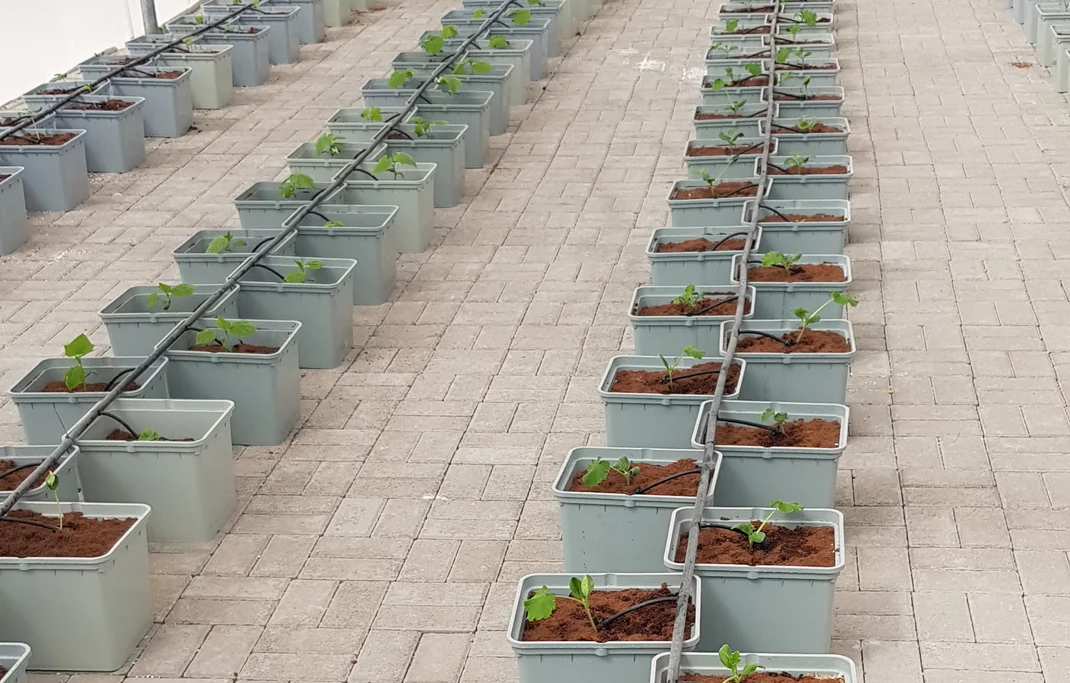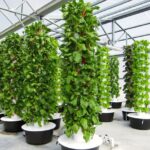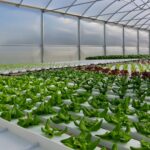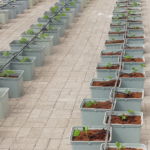One of the biggest advancements in agriculture was the discovery that plants don’t actually need soil to grow
Ever since humans largely switched from nomadic lifestyles to more stationary, agrarian ones, they have experimented with new ways of growing food. One of the biggest advancements in agriculture was the discovery that plants don’t actually need soil to grow. In fact, growing can be made possible through the use of hydroponic systems. With hydroponics, plants get all the nutrients they need without having their roots encased in dirt. Hydroponic plants are often cultivated without a soil-like growing medium.
What is Hydroponics?
At its most basic level, hydroponics is when plants are grown in a nutrient solution rather than soil. Instead of the roots growing down into dirt and gaining nutrients that way, in a hydroponic system, the roots grow into a liquid solution that is fortified with all the essential nutrients for healthy plants.
While it is possible to grow plants hydroponically outside, the vast majority of hydroponic systems are used in greenhouses or other indoor spaces. There are many small, commercially available hydroponic systems that people can use to grow hydroponic plants in their homes.
Hydroponics History
To fully answer the question of “What is hydroponic farming?” we need to take a look at its surprisingly colorful history, which can be divided into ancient and modern.
Ancient History
While they may not have known the science behind it, ancient people figured out that you could grow hydroponic plants without the use of soil.
 The Hanging Gardens of Babylon is perhaps one of the earliest examples of a hydroponic system. One of the seven wonders of the ancient world, it’s often cited as being the first known use of hydroponics to grow plants. Around 600 B.C. near modern day Baghdad in Iraq, the Gardens were said to have existed along the Euphrates River, although it’s likely they were made from terraces rather than anything hanging.
The Hanging Gardens of Babylon is perhaps one of the earliest examples of a hydroponic system. One of the seven wonders of the ancient world, it’s often cited as being the first known use of hydroponics to grow plants. Around 600 B.C. near modern day Baghdad in Iraq, the Gardens were said to have existed along the Euphrates River, although it’s likely they were made from terraces rather than anything hanging.
However, the use of hydroponics in these ancient gardens has been disputed. It should also be noted that the existence of the Gardens themselves is also disputed.
Other ancient growing techniques that definitely existed, but that are only hydroponic-adjacent, include the floating gardens of Mesoamerica in the 1100s, called Chinampas, and similar floating gardens in ancient China that were described by famed explorer Marco Polo in the 1300s (although they likely existed long before that).

The Chinampas, which were built in shallow lakes, consisted of areas of about 300 by 26 ft with underwater “fences” made of dead reeds that had been interwoven. The enclosed spaces were filled with a unique growing medium: alternating layers of rock, aquatic vegetation, natural waste, and lake bottom soil.
While not truly hydroponic, the Chinampas and floating gardens of ancient China can be considered a distant relative of hydroponics.
Modern History

Jumping ahead a few hundred years, the first known published work to discuss a hydroponic system (growing plants without the use of soil) was Sylva Sylvarum, or, A Natural History in Ten Centuries by Francis Bacon and William Rawley, published in 1626.
Also in the 1600s, Belgian scientist Jan Baptista van Helmont conducted an experiment that demonstrated plants did not gain mass from soil, as many assumed at the time. He planted a five-pound willow tree in a growing medium of 200 pounds of dry soil. Over a five year period, he only added rain or distilled water into the pot, and after five years he weighed both the plant and the soil again. Van Helmont found that the tree then weighed 169 pounds while the weight of the soil only decreased by two ounces.
While van Helmont believed his experiment showed plants gained mass through water culture alone, English physician John Woodward published a scientific paper about his own experiments in 1699 that showed plants required more than just water as a growing medium to thrive.
In his experiments, Woodward grew spearmint using various types of water culture—from completely pure to water collected from the Thames River. He found that plants grown in less pure water grew better than ones in purer water, thus concluding that they required more than just water to grow.
Jumping ahead another century or so, German scientists Julius von Sachs and Wilhelm Knop developed nutrient solution recipes in the 1860s and helped identify the necessary nutrients plants need to grow.
Another leap forward brings us to the 1930s and we finally get to the word “hydroponic,” stemming from the Greek words for “water” and “labor.” William Frederick Gericke, a plant physiologist at the University of California, Berkeley, coined the term, and this is where the history gets a bit colorful.
Gericke researched the growing of plants using only a nutrient solution, and he actually grew his own crops for personal use with the method. This was widely reported by books, newspapers and magazines at the time, which all hailed it as a revolution in agriculture. The University of California was besieged by requests from the general public to give them information on this new hydroponic growing method.
However, because Gericke researched hydroponics on his own time rather than as part of his job, he did not feel obligated to share his nutrient formulas or methods with his employers or the general public for free. This angered his employers at the University and they, in turn, appointed two of their top scientists to study hydroponics and write an information bulletin for the general public.
Gericke eventually left the University and wrote a book about his hydroponic growing methods.
Meanwhile, the secret was officially out and hydroponics evolved from there into its modern form (or, technically, several modern forms as described below).
How Does Hydroponics Work?
As the root of the word “hydroponics” implies, the water (hydro) does the work or labor (ponos) in hydroponic gardening.
To grow, plants need a few essential ingredients: light, carbon dioxide (which they usually get from general air flow in their environment), water, and nutrients. In traditional gardening, plants get the nutrients they need from soil.
In hydroponics, rather than plants absorbing nutrients from soil, they absorb those nutrients from a liquid nutrient solution, which is mixed in with the water.
Growing in soil can drastically affect a plant’s root architecture and its ability to produce food because nutrients may not be spread evenly throughout the soil.
On the other hand, growing in liquid solution guarantees the plants’ roots all have consistent access to nutrients at all times, meaning their nutrient uptake and growth is more efficient. This causes the plants to grow quicker and larger than if they were grown in soil.
The Basic Components of A Hydroponic System.
Not all hydroponics systems are the same, but they do all have some common components. They all have some kind of growing tray where the plants actually grow. In some systems, these trays have only water and the liquid nutrient solution in them, and in other systems the plants grow in a non-soil material like sand, rock or wool.
 Hydroponics systems will usually have a nutrient reservoir where excess nutrient solution is kept. The systems must have a way to get the nutrient solution into the growing tray. This can be done actively by an electric water pumping mechanism or passively by the use of wicks.
Hydroponics systems will usually have a nutrient reservoir where excess nutrient solution is kept. The systems must have a way to get the nutrient solution into the growing tray. This can be done actively by an electric water pumping mechanism or passively by the use of wicks.
Some systems include air pumps and air stones in the reservoirs to keep the nutrient solution in motion at all times.
Hydroponic growing systems usually also have growing lights as part of their operations. Often, larger hydroponics systems will have some kind of software that monitors the plants and keeps track of them. Even smaller systems tend to rely on timers to keep a regular schedule for watering and light usage.
And, of course, the most important element of any hydroponics system is the nutrient solution itself, which is added to the water.
Types of Hydroponic Systems
Hydroponics systems come in all sizes, from little indoor herb gardens that sit on your kitchen counter, to massive industrial scale operations that take up entire warehouses. Today’s systems are extremely sophisticated and larger scale ones may include sensors, cameras, and artificial intelligence (AI) software to closely monitor plants.
The three main types of hydroponic growing systems are:
- Nutrient Film
- Ebb and Flow
- Wick
Nutrient Film

The most common type of hydroponics system in use today is one that uses a nutrient film technique. A nutrient film system grows plants in a growing tray that is slightly tilted and positioned above a nutrient solution reservoir.
Water is pumped from the reservoir into the growing trays. Because the trays are angled, this nutrient film technique allows a thin stream of water to flow over the plants’ roots and then empty back into the reservoir below. It is an entirely closed system.
Ebb and Flow
In an ebb and flow hydroponic system, rather than having a continuous stream of water flowing over the roots, the plant roots are flooded with the nutrient/water mixture. The water is continuously emptied back into the reservoir to be reused.
Wick
 A wick system has the same growing-tray-above-and-reservoir-below setup as the other two systems, but it also requires a non-soil growing media like sand, rock, wool or clay balls to help anchor the roots in the growing tray. The nutrient-rich water is passed from the reservoir up to the roots in the growing tray via a wick or a piece of string. This system does not require the use of an electric water pump.
A wick system has the same growing-tray-above-and-reservoir-below setup as the other two systems, but it also requires a non-soil growing media like sand, rock, wool or clay balls to help anchor the roots in the growing tray. The nutrient-rich water is passed from the reservoir up to the roots in the growing tray via a wick or a piece of string. This system does not require the use of an electric water pump.
Hydroponics vs Soil – What are the Advantages?
As mentioned previously, growing plants in a liquid nutrient solution affects the root architecture of plants, causing them to grow more efficiently than in soil. This is the most obvious advantage of a hydroponics system, but there are other advantages, as well.
Advantages
Their unique nature gives hydroponics systems an edge over traditional ways of growing.
More Plant Density
Because they’re not stuck in dirt, plants can easily be moved as they grow. Hydroponic greenhouses often have a room dedicated to germination and seedling production, so they can perform these preliminary steps before moving adult plants into the main growing area. 
Growing plants in liquid also decreases the area required for them to grow than if they were grown in soil, meaning more plants can be grown in the same amount of space.
Add in the fact that you can grow plants vertically, like Bowery, and you can fit a lot more plants in the same amount of land area than growing with soil. For example, in a warehouse measuring 25,000 square feet, we can grow many more plants than a plot of land with the same square footage because we can grow them on levels going upwards.
Higher Crop Yields

It is common for hydroponic greenhouses to report higher yields and better quality produce than traditional growing operations. This is especially achievable today with the use of AI to monitor plants.
Less Water Waste
In hydroponics systems where the roots are encased in a closed trough or tube, less water evaporates than in soil growing systems, meaning less water is wasted. In this regard, it is a closed system.

Disadvantages
We would be remiss if we didn’t also acknowledge that there are some perceived disadvantages to hydroponic gardening.
Larger Initial Investment
At smaller sizes, soil growing requires few tools and thus it doesn’t cost much to get started. Using our 25,000 square foot plot example, you would only really need seeds, some fertilizer, maybe an irrigation system, and some hand tools to tend a plot of land this size.
However, with a hydroponics system, you will also need to add in the cost of a building, pumps, tanks, controls – like cameras and a software system that monitors the plants – and a supplemental lighting system. This all adds several dollars per square foot.
Higher Energy Costs
When growing outdoors in soil, the sun takes care of the lighting and (unless you have an irrigation system), the clouds take care of watering the plants. In a hydroponics system, your pumps, lighting, cameras and sensors all require electricity, which bumps up your energy consumption and costs.
More Technical Skill is Required
 While traditional growing does require some skills and knowledge, the basics are quite intuitive and easy to learn. When using hydroponics, you’ll need to be knowledgeable about chemistry, you’ll need to know how to use the monitoring and growing systems, and you’ll also need basic plant production knowledge. The learning curve is a bit steeper than traditional growing.
While traditional growing does require some skills and knowledge, the basics are quite intuitive and easy to learn. When using hydroponics, you’ll need to be knowledgeable about chemistry, you’ll need to know how to use the monitoring and growing systems, and you’ll also need basic plant production knowledge. The learning curve is a bit steeper than traditional growing.
How Hydroponics is Used At Bowery
While hydroponics does come with some perceived disadvantages, at Bowery Farming, we have mitigated these with our own unique way of vertical farming.
Tech-Enabled Irrigation
It’s true that learning a software system takes some time, but once you’ve learned how to use the system, it takes care of all the growing parameters for you in the most efficient way possible.
 The proprietary BoweryOS knows the exact nutrient mix and watering schedule for every cultivar we grow, and it administers the right amount of water and nutrients to each tray of plants in the growing room.
The proprietary BoweryOS knows the exact nutrient mix and watering schedule for every cultivar we grow, and it administers the right amount of water and nutrients to each tray of plants in the growing room.
All our water is brought in from the municipal water supply, filtered multiple times to ensure no contaminants are present, and enriched with specific nutrients to help the plants grow.
Enhanced Resource Management
 As mentioned, hydroponic systems waste less water because of decreased evaporation. At Bowery, we take it a step further by recapturing and recycling water. A single Bowery farm saves 15-20 million gallons of water per year compared to traditional agricultural practices.
As mentioned, hydroponic systems waste less water because of decreased evaporation. At Bowery, we take it a step further by recapturing and recycling water. A single Bowery farm saves 15-20 million gallons of water per year compared to traditional agricultural practices.
Renewable Energy
There is no doubt that hydroponic growing is energy intensive. However, there are ways that Bowery mitigates the amount of energy used, like thermal insulation and the use of renewable energy from sources like low-impact hydro.
Bowery is committed to growing food with renewable energy. Our farms in Maryland and New Jersey, for example, run on 100% renewable energy. That means we avoid using 30 million pounds of CO2 annually.
We plan to power all of our future farms with renewable energy, too.
Purer Food
 For us, this is the biggest advantage of hydroponic, vertical farming, at least the way Bowery does it. All our crops are free from pesticides and herbicides, and our operation does not produce any fertilizer runoff, which is detrimental to local water supplies, local plant life and local wildlife.
For us, this is the biggest advantage of hydroponic, vertical farming, at least the way Bowery does it. All our crops are free from pesticides and herbicides, and our operation does not produce any fertilizer runoff, which is detrimental to local water supplies, local plant life and local wildlife.
The food is purer and the surrounding area does not pay a heavy toll for the growing of it.
At Bowery Farming, we are proud to continue the tradition of hydroponic farming while also looking for new ways to evolve the practice. Hydroponic gardening allows for a unique method of growing food that uses space much more efficiently and provides healthier, more nutritious food to more people







